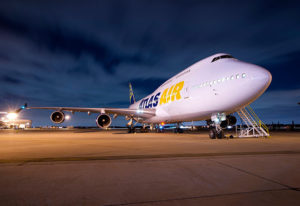 Long before an Atlas flight lifts off for its destination, enormous effort is undertaken company-wide to ensure its journey will be a safe and successful one. Beyond the safety features built into the aircraft, the care and expertise of our teams on the ground and in the air is critical for delivering every one of our 68,000+ flights* a year safely. Safety protocols are in place not just to protect goods on an aircraft, but also to protect the crew.
Long before an Atlas flight lifts off for its destination, enormous effort is undertaken company-wide to ensure its journey will be a safe and successful one. Beyond the safety features built into the aircraft, the care and expertise of our teams on the ground and in the air is critical for delivering every one of our 68,000+ flights* a year safely. Safety protocols are in place not just to protect goods on an aircraft, but also to protect the crew.
At Atlas, safety is a core value, and there are a number of safety programs and best practices in place to support this commitment.
Training
Atlas has one of the most rigorous training programs in the cargo shipping industry with qualified pilots undergoing an approximate three-month training period.
Atlas has established strict pilot certification requirements. Pilots are required to have their ATP license, the pilot’s equivalent of a doctorate. While obtaining an ATP license requires 1,500 to 2,000 flight hours, Atlas Air looks to hire pilots with 3,000 to 4,000 flight hours.
Atlas keeps all training in-house, during which pilots split their time between a classroom and both fixed-base and full-motion simulators. On their first few operational flights, new pilots fly with a “check pilot” to ensure that their training was sufficient.
But pilots aren’t the only employees who benefit from Atlas’ rigorous in-house training approach. With more than 24,000 training events provided each year, every employee who touches the aircraft receives significant training, much of it related to safety.
SMS Implementation
While training provides Atlas with a strong foundation for safety, technology in the form of safety management systems (SMS) has come to play a large role as well. SMS connect multiple data systems and human reporting to ensure pilots and crew are continually aware of any potential issues relating to the aircraft.
SMS relies extensively on reporting from several sources on all levels, during every phase of any flight. SMS requires any and all safety concerns be submitted by anyone with knowledge of these concerns, whether they are pilots or members of the ground crew. The system compiles these reports, assesses risk in real time and sends findings to the crew.
“We have various safety reporting programs where anyone can submit a safety concern to the company, and we’ll take any necessary action,” said Bryan Brown, Senior Director of Safety for Atlas Air.
SMS has become the cornerstone for all safe flight practices and was mandated by the FAA in 2018. But, by then Atlas was ahead of the game. Before the mandate, Atlas proactively participated in a voluntary SMS pilot program. This effort demonstrated Atlas Air’s commitment to going above and beyond established safety protocols.
Ongoing Checks
Training and technology are crucial to keeping pilots and crews safe. But safety doesn’t stop there. Certain tasks are delegated to specific individuals for each flight to ensure nothing falls through the cracks.
One such safety check is a pilot’s maintenance review of each aircraft with the mechanic.
“Once the pilot is seated in the flight deck, he or she will review the aircraft maintenance log prior to flight departure,” Bryan said. “This procedure happens every single flight. Another crew member conducts a safety walk-around to review all major components of the aircraft.”
The checklist continues with the Loadmaster speaking with the Captain to explain what cargo is on board and the loading process, while another crew member does a security check of the materials on board. Depending on the aircraft type, a crew member conducts another walk-around once the cargo is loaded to verify safety mechanisms are in place.
“Safety is the foundation of everything we do,” Bryan said. “Every step our team takes on the ground and in the air is tied to operating safely and compliantly.”
*Based on 2020 data.